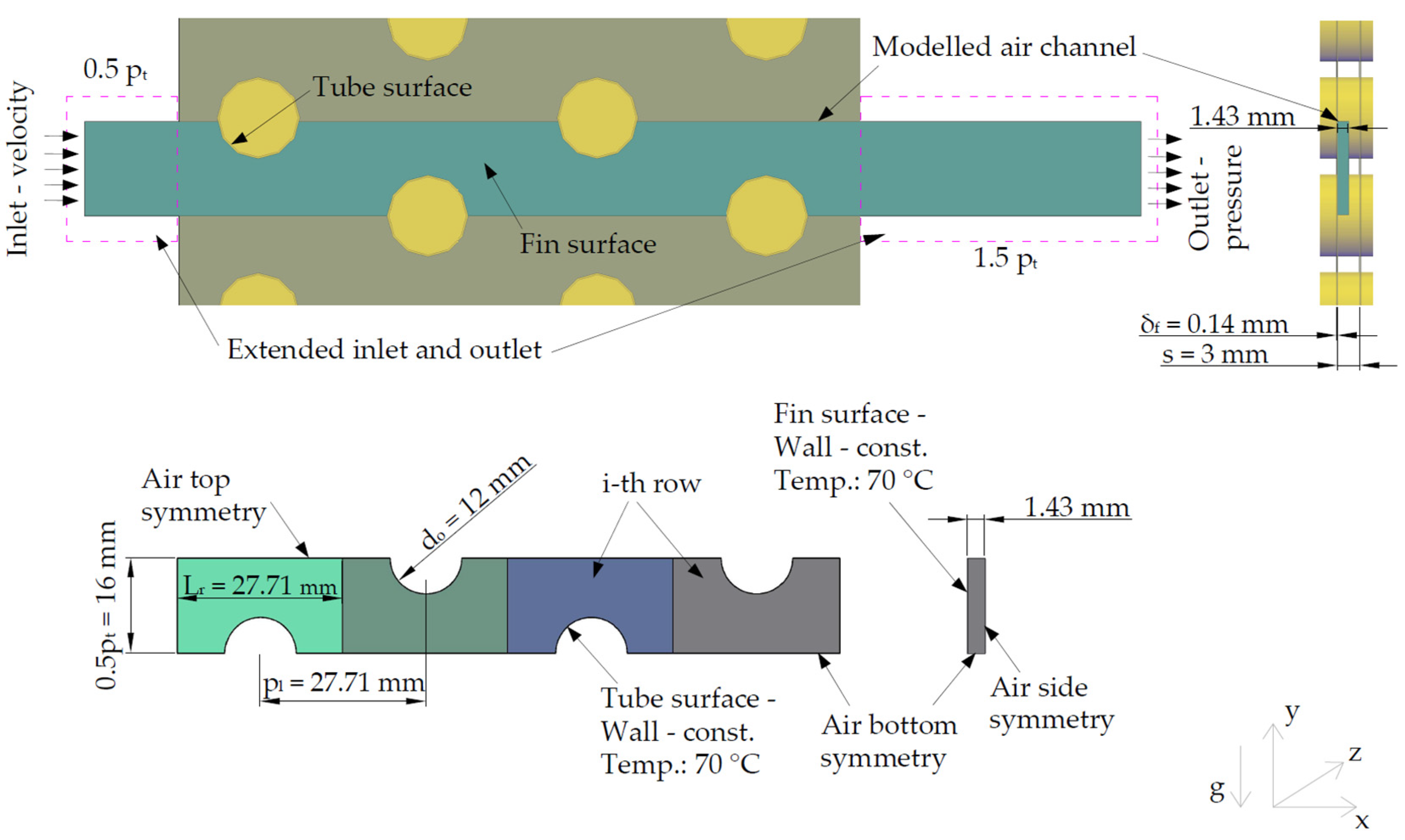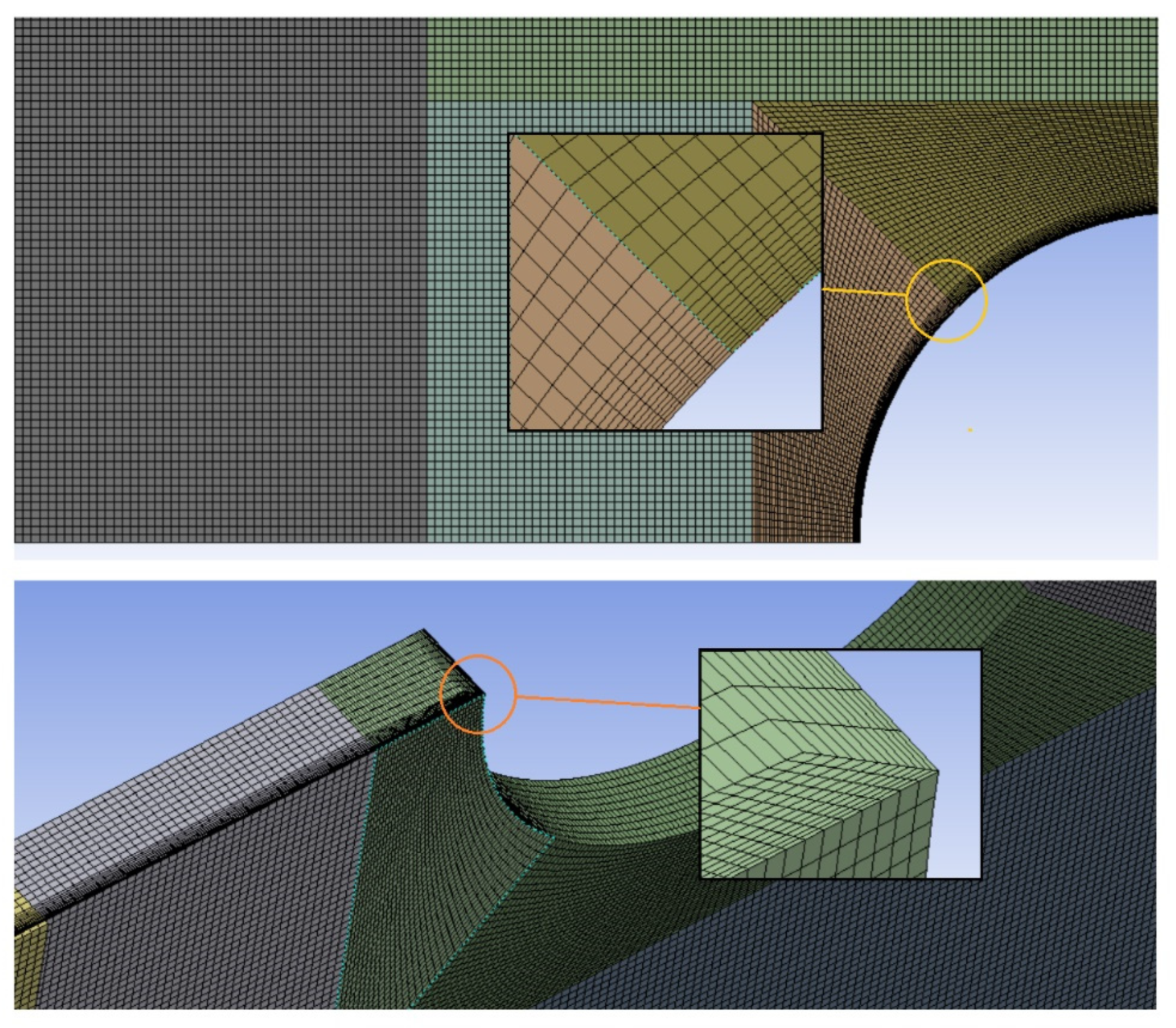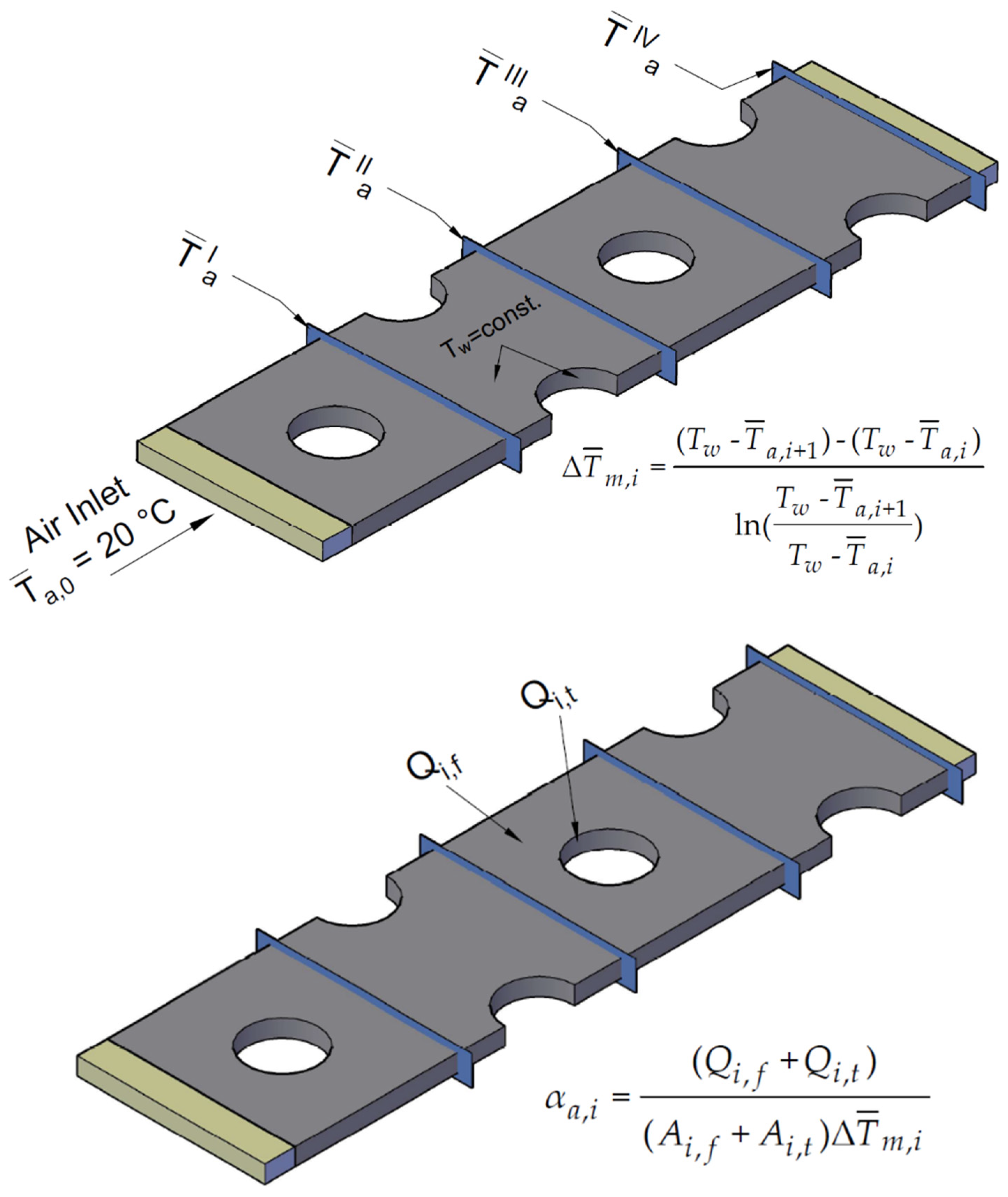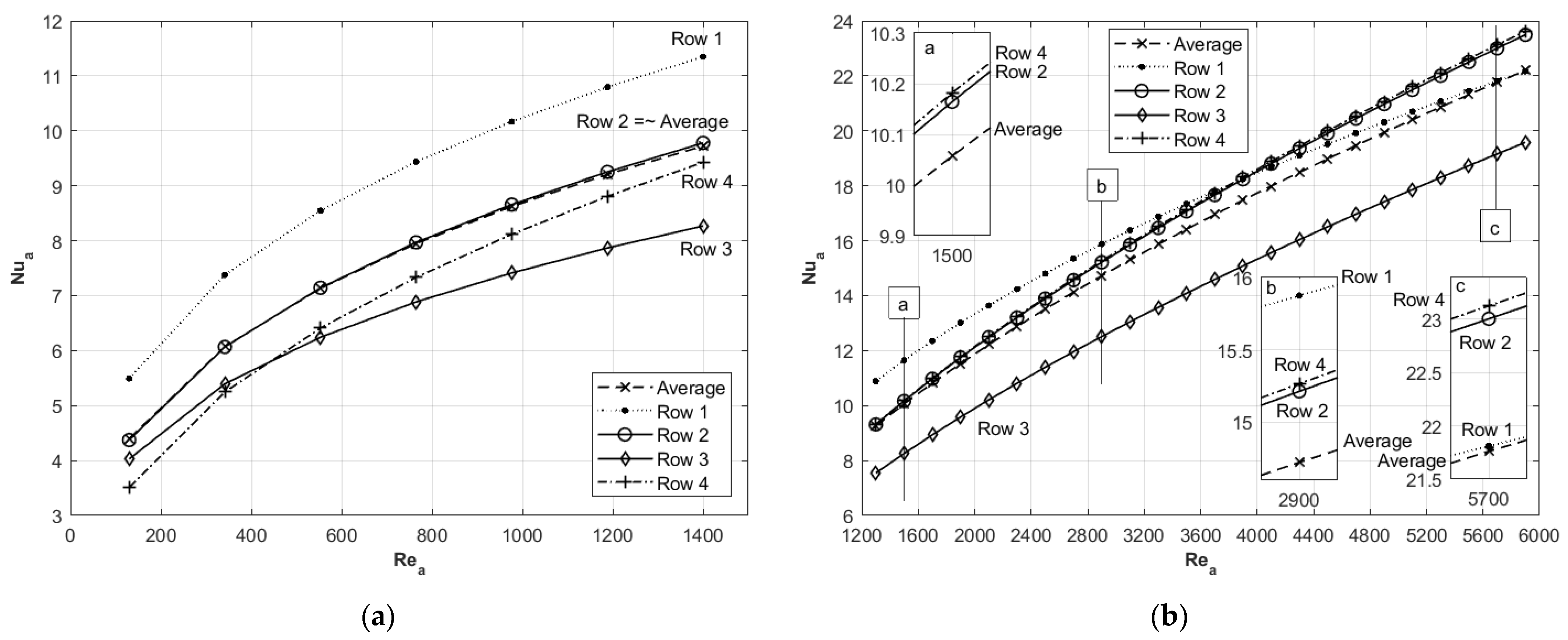Air-Side Nusselt Numbers and Friction Factor’s Individual Correlations of Finned Heat Exchangers
Abstract
:1. Introduction
2. Geometry and CFD Model
3. Assumptions and Data Reduction
- Fixed inlet air temperature: 20 °C.
- Air outlet opening condition-control of medium mass air temperature in the outlet section.
- Fixed air-side fins and tubes surface temperature: 70 °C.
- Air parameters variable as a function of temperature.
- Reynolds-Averaged Navier-Stokes equations of the mass, momentum, and energy conservation were used
- Shear Stress Transport turbulence model.
- The residuals were set to less than The residuals were set to less than 10−3 for the continuity equations and 10−5 for the energy equations, respectively, to ensure that the calculations converge.
- The simulations were done by ANSYS-CFX 2020 R2 software.
4. Mesh Parameters and Mesh Independent Study
5. CFD Model Validation
6. Method of Determining HTC on the Individual FHE Row
- Extract the average mass flow temperature from the Fluent Post-Processor of the air velocity for every row separately. Areas to extract the average mass flow temperatures are in a half distance between the next two tubes in rows.
- Compute the difference of the average logarithmic temperature () 14 between the fin and the tube surface temperature () and the average mass flow temperature () (Equation (12)).
- Extract the total heat flow transferred from the fin and the tube wall surface to the air for the i-th row of the FTHE (Figure 6).
- Compute the individual HTC for each row separately (Equation (13)) [14].
- Compute the Nusselt number (Equation (14)) [14].
- Extract the average value of static pressure from the Fluent CFD-Post of the air velocity for every row separately. Areas to extract the average value of the static pressure are in a half distance between the next two tubes in rows.
- Compute the individual Darcy-Weisbach friction factor for each row separately (Equation (15)) [35].
7. Results and Discussion
8. Conclusions
- The results of the comparison the current average Nusselt number correlations for the entire FHE with author’s previous average Nusselt number correlations for the entire FHE are almost identical. The relative differences for the entire Reynolds number range from 200 to 6000 is maximum 3.6% (Figure 5). The important information is that the current data were calculated using Ansys 2020 R2 Fluent software, whereas the previous author’s data were determined using Ansys 2020 R2 CFX software.
- The obtained Nusselt numbers and D-W friction factors data are the highest value for the first row of the FHE for Reynolds number ranging from 200 to 6000, due to the maximum temperature difference between air and heat transfer surface (fin and tubes). The fewest dead zones exist also in the first row of tubes (Figure 7 and Figure 8).
- The obtained Nusselt number and friction factors correlations showed that the third row is the least efficient for Reynolds number ranging from 200 to 6000, because the third row is the least turbulent and air stream develops a narrow flow channel. The rest of the volume creates broad dead zones in front of and behind the tubes in the third row (Figure 7 and Figure 8).
- The greater the Reynolds number for the range tested, the more the Nusselt number values for the first row converge to the average value for the entire FHE. Moreover, the higher the Reynolds number for the range tested, the more the Nusselt values for the second- and the third-row values equalise and increase from the mean value for the entire FHE (Figure 7).
- The research also showed the clear and accessible method for the determination of the Nusselt number and friction factor correlation for individual rows which can reduce or even completely eliminate expensive experimental research (Figure 6).
- The presented method (Figure 6) can be used not only for designing coolers and heaters in air-conditioning or other finned heat exchangers in heat recovery, but also for evaporators and condensers in air heat pump, cooling, and refrigeration process.
Author Contributions
Funding
Institutional Review Board Statement
Informed Consent Statement
Data Availability Statement
Conflicts of Interest
Nomenclature
| A = Aw | total surface area (fin and tube outer surface area), m2 |
| Af | fin surface aream2 |
| Amin | minimum air flow area, m2 |
| At | outer tube area, m2 |
| CFD | Computational Fluid Dynamics |
| D–W | Darcy–Weisbach (friction factor) |
| diffCorr | different correlation, e.g., Wang et al. or Marcinkowski et al. |
| dh | hydraulic diameter, m |
| do | outer tube diameter, m |
| do,min | the minimum dimension between tubes, m |
| e | relative differences, % |
| f | Darcy–Weisbach friction factor |
| FHE | Finned Heat Exchanger |
| g | gravity, m/s2 |
| HTC | Heat Transfer Coefficient |
| Lr = pl | length of single row, m |
| n | number of mesh elements |
| Nua | Nusselt number based on the hydraulic diameter |
| Nudo | Nusselt number based on the outer diameter of the tube |
| Nuni | Nusselt number for mesh with particular element numbers |
| Nu3,104,268 | Nusselt number for mesh with 3,104,268 mesh elements |
| param | Considered parameter: Nusselt Number or D-W friction factor |
| PCM | Phase Change Materials |
| average air pressure drop, Pa | |
| pt | longitudinal fin pitch, m |
| pl | transversal fin pitch, m |
| Pra | Prandtl number |
| s | fin pitch, m |
| Rea | Reynolds number based on the hydraulic diameter |
| Redo | Reynolds number based on the outer diameter of the tube |
| mass average air temperature, °C | |
| log mean temp. difference, °C | |
| Tw | constant wall temperature, °C |
| w | air velocity, m/s |
| Va | total volume of one row or entire FHE, m3 |
| Vo | volume through which air flows, m3 |
| Vt | volume of tube in one row or in entire FHE, m3 |
| Q | total heat transfer, W |
| Qf | total heat transfer of fin, W |
| Qt | total heat transfer of tube, W |
| x1 | Nusselt number parameter |
| x2 | Nusselt number parameter |
| y+ | dimensionless wall distance |
| x, y, z | axis description |
| Greek Symbols: | |
| heat transfer coefficient, W/(m2·K) | |
| fin thickness, m | |
| thermal conductivity, W/(m·K) | |
| kinematic viscosity, m2/s | |
| air density in i-th row cross section, kg/m3 | |
| arithmetic average of the air density for i-th row, kg/m3 | |
| ratio of the fin pitch cross section and two next fins distance cross section area | |
| mean standard deviation | |
| Subscripts: | |
| a | air |
| f | fin |
| i | the inlet of the i-th tube row |
| i+1 | the inlet of the (I + 1)-th tube row |
| max | maximum |
| t | tube |
| 0 | air inlet |
| Superscripts: | |
| I, II, III and IV | number of FHE row |
| Present | data/correlation from the present research |
References
- McQuistion, F.C.; Parker, J.D.; Spitler, J. Heating, Ventilating, and Air Conditioning Analysis and Design, 6th ed.; JohnWiley & Sons: Hoboken, NJ, USA, 2005. [Google Scholar]
- Menegazzo, D.; Lombardo, G.; Bobbo, S.; De Carli, M.; Fedele, L. State of the Art, Perspective and Obstacles of Ground-Source Heat Pump Technology in the European Building Sector: A Review. Energies 2022, 15, 2685. [Google Scholar] [CrossRef]
- Marina, A.; Spoelstra, S.; Zondag, H.A.; Wemmers, A.K. An estimation of the European industrial heat pump market potential. Renew. Sustain. Energy Rev. 2021, 139, 110545. [Google Scholar] [CrossRef]
- Moon, H.; McGregor, D.J.; Miljkovic, N.; King, W.P. Ultra-power-dense heat exchanger development through genetic algorithm design and additive manufacturing. Joule 2021, 5, 3045–3056. [Google Scholar] [CrossRef]
- Guo, X.; Wei, H.; He, X.; Du, J.; Yang, D. Experimental evaluation of an earth–to–air heat exchanger and air source heat pump hybrid indoor air conditioning system. Energy Build. 2022, 256, 111752. [Google Scholar]
- Wang, W.; Jiang, J.; Hu, B.; Wang, R.Z.; Luo, M.; Zhang, G.; Xiang, B. Performance improvement of air-source heat pump heating system with variable water temperature difference. Appl. Therm. Eng. 2022, 210, 118366. [Google Scholar] [CrossRef]
- Yang, T.; King, W.P.; Miljkovic, N. Phase change material-based thermal energy storage. Cell Rep. Phys. Sci. 2021, 2, 100540. [Google Scholar] [CrossRef]
- Du, K.; Calautit, J.; Eames, P.; Wu, Y. A state-of-the-art review of the application of phase change materials (PCM) in Mobilized-Thermal Energy Storage (M-TES) for recovering low-temperature industrial waste heat (IWH) for distributed heat supply. Renew. Energy 2021, 168, 1040–1057. [Google Scholar] [CrossRef]
- Najim, F.T.; Mohammed, H.I.; Taqi Al-Najjar, H.M.; Thangavelu, L.; Mahmoud, M.Z.; Mahdi, J.M.; Tiji, M.E.; Yaïci, W.; Talebizadehsardari, P. Improved Melting of Latent Heat Storage Using Fin Arrays with Non-Uniform Dimensions and Distinct Patterns. Nanomaterials 2022, 12, 403. [Google Scholar] [CrossRef] [PubMed]
- Mahdi, J.M.; Najim, F.T.; Aljubury, I.M.A.; Mohammed, H.I.; Khedher, N.B.; Alshammari, N.K.; Cairns, A.; Talebizadehsardari, P. Intensifying the thermal response of PCM via fin-assisted foam strips in the shell-and-tube heat storage system. J. Energy Storage 2022, 45, 103733. [Google Scholar] [CrossRef]
- Sun, X.; Mohammed, H.I.; Tiji, M.E.; Mahdi, J.M.; Majdi, H.S.; Wang, Z.; Talebizadehsardari, P.; Yaïci, W. Investigation of Heat Transfer Enhancement in a Triple Tube Latent Heat Storage System Using Circular Fins with Inline and Staggered Arrangements. Nanomaterials 2021, 11, 2647. [Google Scholar] [CrossRef] [PubMed]
- Rao, R.V.; Saroj, A.; Ocloń, P.; Taler, J. Design Optimization of Heat Exchangers with Advanced Optimization Techniques: A Review. Arch. Comput. Methods Eng. 2019, 27, 517–548. [Google Scholar] [CrossRef]
- Taler, D.; Taler, J.; Trojan, M. Thermal calculations of plate–fin–and-tube heat exchangers with different heat transfer coefficients on each tube row. Energy 2020, 203, 117806. [Google Scholar] [CrossRef]
- Thulukkanam, K. Heat Exchanger Design Handbook, 2nd ed.; CRC Press: Boca Raton, FL, USA, 2013. [Google Scholar]
- Bošnjaković, M.; Muhič, S. Numerical Analysis of Tube Heat Exchanger with Trimmed Star-Shaped Fins. Appl. Sci. 2022, 12, 4857. [Google Scholar] [CrossRef]
- Hassan, M.; Mebarek-Oudina, F.; Faisal, A.; Ghafar, A.; Ismail, A.I. Thermal energy and mass transport of shear thinning fluid under effects of low to high shear rate viscosity. Int. J. Thermofluids 2022, 15, 100176. [Google Scholar] [CrossRef]
- Sadeghianjahromi, A.; Wang, C.C. Heat transfer enhancement in fin-and-tube heat exchangers—A review on different mechanisms. Renew. Sustain. Energy Rev. 2021, 137, 110470. [Google Scholar] [CrossRef]
- Zhang, J.; Liu, J.; Zhang, L.; Liu, Q.; Wu, Q. Air-side heat transfer characteristics under wet conditions at lower ambient pressure of fin-and-tube heat exchanger. Int. J. Heat Mass Transf. 2019, 142, 118439. [Google Scholar] [CrossRef]
- Jige, D.; Sugihara, K.; Inoue, N. Evaporation heat transfer and flow characteristics of vertical upward flow in a plate-fin heat exchanger. Int. J. Refrig. 2022, 133, 165–171. [Google Scholar] [CrossRef]
- Vaisi, A.; Javaherdeh, K.; Moosavi, R. Condensation heat transfer performance in multi-fluid compact heat exchangers with wavy and strip fins. Int. J. Heat Mass Transf. 2022, 182, 121968. [Google Scholar] [CrossRef]
- Xie, G.; Wang, Q.; Sunden, B. Parametric study and multiple correlations on air-side heat transfer and friction characteristics of fin-and-tube heat exchangers with large number of large-diameter tube rows. Appl. Therm. Eng. 2008, 29, 1–16. [Google Scholar] [CrossRef] [Green Version]
- Kim, Y.; Kim, Y. Heat transfer characteristics of flat plate finned-tube heat exchangers with large fin pitch. Int. J. Refrig. 2005, 28, 851–858. [Google Scholar] [CrossRef]
- Che, M.; Elbel, S. Comparison of Local and Averaged Air-Side Heat Transfer Coefficients on Fin-and-Tube Heat Exchangers Obtained With Experimental and Numerical Methods. J. Therm. Sci. Eng. Appl. 2022, 14, 071013. [Google Scholar] [CrossRef]
- Węglarz, K.; Taler, D.; Jaremkiewicz, M.; Taler, J.; Marcinkowski, M. Analytical-numerical method for calculating cross-flow tube heat exchangers considering temperature-dependent fluid heat capacities. Int. J. Heat Mass Transf. 2022, 183, 122202. [Google Scholar] [CrossRef]
- Marcinkowski, M.; Taler, D.; Taler, J.; Węglarz, K. Thermal Calculations of Four-Row Plate-Fin and Tube Heat Exchanger Taking into Account Different Air-Side Correlations on Individual Rows of Tubes for Low Reynold Numbers. Energies 2021, 14, 6978. [Google Scholar] [CrossRef]
- Kelvion. Compact Fin and Tube Coils. Available online: https://www.kelvion.com/products/product/coils/ (accessed on 26 June 2022).
- Wang, C.C.; Hsieh, Y.C.; Lin, Y.T. Performance of Plate Finned Tube Heat Exchangers Under Dehumidifying Conditions. J. Heat Transf. 1997, 119, 109–117. [Google Scholar] [CrossRef]
- Wang, C.C.; Chang, Y.J.; Hsieh, Y.C.; Lin, Y.T. Sensible heat and friction characteristics of plate fin-and-tube heat exchangers having plane fins. Int. J. Refrig. 1996, 19, 223–230. [Google Scholar] [CrossRef]
- Li, H.; Zhang, S.; Ji, Y.; Sun, M.; Li, X.; Sheng, Y. The influence of catchment scale on comprehensive heat transfer performance about tube fin heat exchanger in numerical calculation. Energy Rep. 2022, 8, 147–155. [Google Scholar] [CrossRef]
- Menéndez Pérez, A.; Fernández-Aballí Altamirano, C.; Borrajo Pérez, R. Parametric analysis of the influence of geometric variables of vortex generators on compact louver fin heat exchangers. Therm. Sci. Eng. Prog. 2021, 27, 101151. [Google Scholar] [CrossRef]
- Zeeshan, M.; Nath, S.; Bhanja, D. Numerical study to predict optimal configuration of fin and tube compact heat exchanger with various tube shapes and spatial arrangements. Energy Convers. Manag. 2017, 148, 737–752. [Google Scholar] [CrossRef]
- Zhao, L.; Gu, X.; Gao, L.; Yang, Z. Numerical study on airside thermal-hydraulic performance of rectangular finned elliptical tube heat exchanger with large row number in turbulent flow regime. Int. J. Heat Mass Transf. 2017, 114, 1314–1330. [Google Scholar] [CrossRef]
- Okbaz, A.; Pınarbas, A.; Olcay, A.B.; Aksoy, H. An experimental, computational and flow visualization study on the air-side thermal and hydraulic performance of louvered fin and round tube heat exchangers. Int. J. Heat Mass Transf. 2018, 121, 153–169. [Google Scholar] [CrossRef]
- ANSYS FLUENT 12.0 Theory Guide—1.2 Continuity and Momentum Equations. Available online: https://www.afs.enea.it/project/neptunius/docs/fluent/html/th/node11.htm (accessed on 25 July 2022).
- Kays, W.; London, A. Compact Heat Exchangers, 3rd ed.; Krieger Pub Co.: Malabar, FL, USA, 1998. [Google Scholar]








| Description | Designation | Value |
|---|---|---|
| Rows | - | 4 |
| Transversal tube pitch | 32 mm | |
| Longitudinal tube pitch | 27.71 mm | |
| Tube outer diameter | 12 mm | |
| Fin pitch | 3 mm | |
| Fin thickness | 0.14 mm | |
| Fin length of single row | 27.71 mm |
| Finite Elements Number | 3,104,268 |
| Number of nodes | 3,277,429 |
| Dimension of the element, mm | 0.15 |
| Maximum dimension of the element, mm | 0.20 |
| Boundary layer | First layer thickness: 0.023 mm |
| Growth rate: 1.1 | |
| Number of layers: 12 | |
| Minimum orthogonal angle | Air: 35.6° |
| Mesh expansion factor | Air: 14 |
| Maximum aspect ratio | Air: 22 |
| Description | Designation | Current Study | Wang et al. [28] | Wang et al. [27] |
|---|---|---|---|---|
| Rows | - | 4 | 2–6 | 2–6 |
| Transversal tube pitch [mm] | 32.00 | 25.40 | 25.40 | |
| Longitudinal tube pitch [mm] | 27.71 | 22.00 | 22.00 | |
| Tube outer diameter [mm] | 12.00 | 10.23 | 10.23 | |
| Fin pitch [mm] | 3.00 | 1.75–3.21 | 1.82–3.20 | |
| Fin thickness [mm] | 0.14 | 0.13–0.2 | 0.13 | |
| Fin length of single row [mm] | 27.71 | 22.00 | 22.00 |
| Nusselt Number Correlations | Friction Factor Correlations | |
|---|---|---|
| Average | ||
| Row 1 | ||
| Row 2 | ||
| Row 3 | ||
| Row 4 |
| Nusselt Number Correlations | Friction Factor Correlations | |
|---|---|---|
| Average | ||
| Row 1 | ||
| Row 2 | ||
| Row 3 | ||
| Row 4 |
Publisher’s Note: MDPI stays neutral with regard to jurisdictional claims in published maps and institutional affiliations. |
© 2022 by the authors. Licensee MDPI, Basel, Switzerland. This article is an open access article distributed under the terms and conditions of the Creative Commons Attribution (CC BY) license (https://creativecommons.org/licenses/by/4.0/).
Share and Cite
Marcinkowski, M.; Taler, D.; Taler, J.; Węglarz, K. Air-Side Nusselt Numbers and Friction Factor’s Individual Correlations of Finned Heat Exchangers. Energies 2022, 15, 5630. https://doi.org/10.3390/en15155630
Marcinkowski M, Taler D, Taler J, Węglarz K. Air-Side Nusselt Numbers and Friction Factor’s Individual Correlations of Finned Heat Exchangers. Energies. 2022; 15(15):5630. https://doi.org/10.3390/en15155630
Chicago/Turabian StyleMarcinkowski, Mateusz, Dawid Taler, Jan Taler, and Katarzyna Węglarz. 2022. "Air-Side Nusselt Numbers and Friction Factor’s Individual Correlations of Finned Heat Exchangers" Energies 15, no. 15: 5630. https://doi.org/10.3390/en15155630
APA StyleMarcinkowski, M., Taler, D., Taler, J., & Węglarz, K. (2022). Air-Side Nusselt Numbers and Friction Factor’s Individual Correlations of Finned Heat Exchangers. Energies, 15(15), 5630. https://doi.org/10.3390/en15155630








